
Eudonia philerga is a species of moth of the family Crambidae. This species was first described by Edward Meyrick. It is endemic to New Zealand, found throughout the country, and regarded as common. Larvae feed on moss. Adult moths have been observed on the wing more frequently from October to April, and are attracted to light.
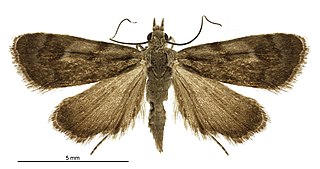
Glaucocharis is a genus of moths of the family Crambidae first described by Edward Meyrick in 1938. The type species for this genus is Glaucocharis stella.

Glaucocharis chrysochyta is a species of moth in the family Crambidae. This species was first described by Edward Meyrick in 1882. It is endemic to New Zealand and is found throughout the country. It inhabits native forest. Larvae appear to feed on moss and likely pupate there. Adult moths are on the wing from November to March. They fly at night and are attracted to light.

Orocrambus xanthogrammus is a moth in the family Crambidae. It was described by Edward Meyrick in 1883. It is endemic to New Zealand, where it has been recorded from the South Island and the eastern part of the North Island. The habitat of this species consists of shingle river beds.

Glaucocharis bipunctella is a moth in the family Crambidae. It was described by Francis Walker in 1866. This species is endemic to New Zealand and has been found in the Auckland region, in the southern parts of the North Island and in the Nelson region. It inhabits dense native forest. Larvae of this species have been raised on liverworts. Adults are on the wing in November to January and are attracted to light.

Glaucocharis auriscriptella, also known as the yellow silverling or silver marked yellow, is a moth in the family Crambidae. It was first described by Francis Walker in 1864 and is endemic to New Zealand. This species can be found in the North, South, Stewart and Great Barrier Islands. The preferred habitat of this moth is lowland and subalpine native forest as well as wetlands. The larvae feed on moss. The adult moth is day flying and is on the wing from November to February. It can be observed in colonies and can be attracted to light at night. This species likely has only one generation per year.
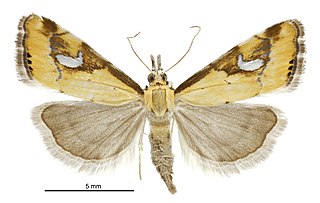
Glaucocharis lepidella is a species of moth in the family Crambidae. It was described by Francis Walker in 1866. It is endemic to New Zealand and is found in both the North and South Island. The species inhabits lowland to subalpine native forest. Larvae may feed on mosses. Adults are on the wing from November to February and are attracted to light.

Glaucocharis epiphaea is a species of moth in the family Crambidae. It was described by Edward Meyrick in 1885. It is endemic to New Zealand and has been observed in both the North and South Islands. G. epiphaea prefers mountainous habitat and frequents very damp spots including alpine and subalpine moss bogs. Larvae feed on the moss Dawsonia superba. Adults are on the wing from September until March and are diurnal.
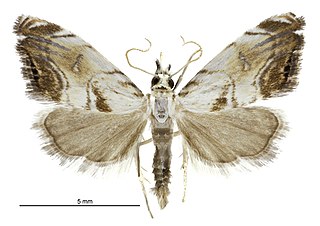
Glaucocharis harmonica is a moth in the family Crambidae. This species was described by Edward Meyrick in 1888. It is endemic to New Zealand and is found in the North and South Islands. It inhabits lowland to subalpine native forest. It has been hypothesised that there are two broods per year. The larval hosts are unknown. Adults are on the wing from October until January.
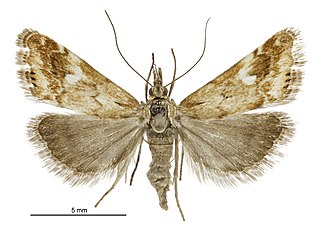
Glaucocharis helioctypa is a moth in the family Crambidae. It was first described by Edward Meyrick in 1882. It is endemic to New Zealand and is only found in the South Island. It can be found throughout the South Island and inhabits native forest in lowland to subalpine altitudes. It has an affinity for damp grassy open situations near native forest or scrub. Larvae of Glaucocharis species feed on mosses and liverworts. Adults are on the wing from November until February. It is dayflying and has been observed flying low over cushion bogs and moss fields. Adults have also been observed flying actively in the hottest sunshine.
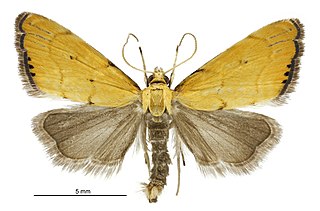
Glaucocharis holanthes is a moth of the family Crambidae. It was first described by Edward Meyrick in 1885. It is endemic to New Zealand and is found in the North and South Islands. This species inhabits native forest or scrub and frequents rock-faces where moss grows. It is apparently attached to places having an exceptionally heavy rainfall. Larvae of Glaucocharis species feed on mosses and liverworts. Adults are on the wing from November to February. It flies very rapidly in hot sunshine and is an elusive insect to catch.

Glaucocharis interruptus is a moth of the family Crambidae. It was first described by Cajetan von Felder, Rudolf Felder and Alois Friedrich Rogenhofer in 1875. It is endemic to New Zealand and is found in the North and South Islands. This species inhabits native forest and scrub at lowland and subalpine altitudes. It has been observed in scrub in river valleys or in mountain ravines. Larvae of Glaucocharis species feed on mosses and liverworts. Adults can be distinguished from similar appearing species by the Y-shaped reniform. They are on the wing from October to March and it is likely this species has two broods a year.

Glaucocharis leucoxantha is a moth in the family Crambidae. It was first described by Edward Meyrick in 1882. It is endemic to New Zealand and can be found in the North, South and Stewart Islands. This species inhabits native forest. Hudson states this species can be met with in South Island native beech forests at elevations of from 1,500 to 2,500 feet above the sea-level. Larvae of Glaucocharis species feed on mosses and liverworts. Adults are on the wing from November until February. This species is very variable in colouration and can be confused with G. lepidella. However it is smaller in size and the crescent shaped spot on its forewings is white or yellow rather than the silver of G. lepidella.

Glaucocharis metallifera is a moth of the family Crambidae. It was first described by Arthur Gardiner Butler in 1877. It is endemic to New Zealand and is found in the southern half of the North Island and the northern half of the South Island. It inhabits native forest at lowland and subalpine altitudes and frequents banks of streams flowing through dense forest clad valleys. The larval host is moss and the larvae are very active and live in galleries in wet moss, on logs or stones in the forest. Adults are on the wing from October to February. It has been hypothesised that this species has two broods per year. Adults have been collected via netting at dusk.
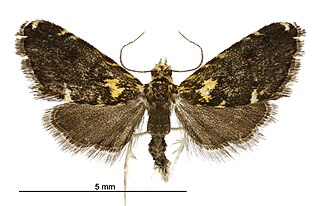
Glaucocharis microdora is a moth of the family Crambidae. It was first described by Edward Meyrick in 1905. It is endemic to New Zealand and is found in the southern parts of the North Island and the north and central parts of the South Island. It inhabits native forest at lowland to subalpine altitudes. The larvae of this species feeds on moss and adults are on the wing from November until February. It is similar in appearance to G. pyrsophanes but can be distinguished as G. microdora is of a smaller size and has bright yellow markings. It also lacks the broad white bars on forewings of G. pyrophanes.

Glaucocharis parorma is a moth of the family Crambidae. It was first described by Edward Meyrick in 1924. It is endemic to New Zealand and is found in the North Island. This species inhabits native forest from lowland to subalpine altitudes. Larvae of Glaucocharis species feed on mosses and liverworts. Adults are on the wing from October to February. This species is very similar in appearance to G. elaina but can be distinguished as a result of the black terminal dots on its forewings.
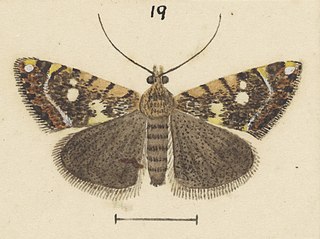
Glaucocharis planetopa is a moth of the family Crambidae. It was first described by Edward Meyrick in 1923. It is endemic to New Zealand and has only be observed on the South Island. G. planetopa inhabits native forest. Larvae of Glaucocharis species feed on mosses and liverworts. Adults are on the wing in January and February. As at 1971 the female of this species had yet to be collected.

Glaucocharis pyrsophanes is a moth in the family Crambidae. It was described by Edward Meyrick in 1882. It is endemic to New Zealand and is found throughout the country including the North, South and Stewart Islands. It inhabits native forest from lowland and subalpine altitudes. It is said to be common in sunny but damp forest openings. Larvae of Glaucocharis species feed on mosses and liverworts. Adults are on the wing from October until February. They are known to feed from and pollinate Leptospermum scoparium and Helichrysum selago.

Glaucocharis stella is a species of moth in the family Crambidae. This species was first described by Edward Meyrick in 1938. It is endemic to New Zealand and has been observed in the North Island. Meyrick hypothesised that larvae of G. stella feed on moss. Adults are on the wing in October and November. The colouration of the forewings ensure that when resting with closed wings on rocks adults are highly camouflaged.

Glaucocharis selenaea is a moth in the family Crambidae. It was first described by Edward Meyrick in 1885. It is endemic to New Zealand and is found throughout the country from Manawatāwhi / Three Kings Islands to Southland including the Little Barrier and Great Barrier Islands. It inhabits native forest from lowland to subalpine altitudes. Larvae of Glaucocharis species feed on mosses and liverworts. Adults are on the wing from October until January and are attracted to light. It can be distinguished from the similar appearing G. metallifera as G. selenaea is smaller in size, the diagonal shaped band, the small round white discal spot and the black-marked veins in the near the end of the forewings.






















